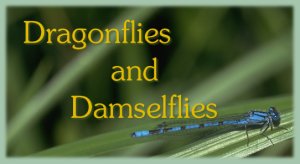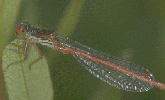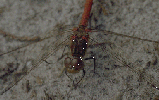

The key has been arranged in such a way that it should be possible to get some way towards a firm identification by observing the behaviour and markings with the naked eye or binoculars, removing the need to catch the insects. This will not always work as many of the females and immature males are very similar in appearance. I have tried to avoid using entomologists jargon where possible but to clarify things I need to remind everyone of the basic structure of insects.
The "typical" insect is divided into three major sections, head, thorax and abdomen. It has six legs and four wings attached to the thorax. It has compound eyes (made up of many small lenses) and complex mouthparts on the head. The abdomen is segmented, usually with ten or eleven segments and the reproductive organs are found at its tip. Dragonflies fit this description very well. The compound eyes are very large to assist the insect with its active hunting lifestyle. The legs are poorly adapted for walking but are excellent for catching prey. The wings are large and transparent and make the dragonflies the most accomplished fliers of the animal kingdom. A friend of mine describes dragonflies as looking like World War I bi-planes. A good description, but they all appear to be flown by Baron Von Richthofen!
Dragonflies are split into two major grouping, Dragonflies and damselflies. True Dragonflies are the bi-plane type, large, powerful and active flyers who spend much of their time hunting for prey. They have huge compound eyes with 30,000 to 40,000 facets. When at rest they hold their wings at right angles to the body. Damselflies are generally smaller. They have a weaker flight and usually stay close to vegetation or to the water surface. Their eyes are smaller and when at rest they usually fold the wing so that they lie in line with the body. A typical Dragonfly and a typical Damselfly are shown below.
 |
 |
|
|
|
The rest of this page is made up of a key to the Dragonflies of Milton Keynes which links to descriptions and some pictures of the eighteen species recorded. If anyone is interested in learning more about Dragonflies, email me (my address is at the bottom of the page) and I'll point you towards the equipment and books you need to get started. I hope you find the key useful.
1. Weak fluttering flight, never far from water. Usually rests with wings held together in line with body, eyes separated, insect never more then 1¾" long, "Devil's Darning Needles" - Damselflies - go to 2.
- Usually strong flyers, often hunting a regular beat, may be found well away from water even in town centre. Usually rests with wings held out at right angles to body, eyes large, touching at some point, insect never less than 1½" long, "Horse Stingers" - Dragonflies - go to 13.
2. Damselflies…
More than 1½" long, electric blue with large black patches on the wings - Banded demoiselle Calopteryx splendens(male) - see description number 1.
- More then 1½" long, metallic green with greenish or pinkish wings - Banded demoiselle Calopteryx splendens(female) - see description number 1.
- Less than 1½" long - go to 3.
3. Abdomen red or red and black, thorax black with red or yellow stripes - Large Red Damselfly Pyrrhosoma nymphula - see description number 2.
- Some other colour then red - go to 4.
4. Metallic, bronzy green body, male has powdery blue marks on segments 2, 9 and 10, rests with wings half open - Emerald Damselfly Lestes sponsa - see description number 3.
- Not metallic green - go to 5.
5. Abdomen mainly blue - go to 6.
- Abdomen black with blue "tail" - go to 8.
- Not like this - go to 9.
6. Pale blue with black markings and white legs - White-legged Damselfly Platycnemis pennipes(male) - see description number 4.
- Abdomen sky-blue and black - go to 7.
 7.
Broad blue shoulder stripes on thorax, 2nd segment of abdomen has a ball on a
stalk mark (figure a) - Common Blue Damselfly
Enallagma cyathigerum (male) - see
description number 5.
7.
Broad blue shoulder stripes on thorax, 2nd segment of abdomen has a ball on a
stalk mark (figure a) - Common Blue Damselfly
Enallagma cyathigerum (male) - see
description number 5.
 - Thin blue shoulder
stripes on thorax, 2nd segment of abdomen has a "U" mark (figure b) -
Azure Damselfly Coenagrion puella
(male) - see description number 6.
- Thin blue shoulder
stripes on thorax, 2nd segment of abdomen has a "U" mark (figure b) -
Azure Damselfly Coenagrion puella
(male) - see description number 6.
8. Abdomen black with blue "tail" segment 8, black thorax with blue stripes, eyes black and blue - Blue-tailed Damselfly Ischnura elegans - see description number 7.
- Thorax black with green, blue, lilac, pink, yellow or brown stripes, blue spot on "tail" segment 8, eyes not reddish - Blue-tailed Damselfly Ischnura elegans - see description number 7.
- Abdomen black or powdery grey with blue "tail" segments 9 and 10, thorax blue and bronzy black, eyes red - Red-eyed Damselfly Erythromma najas (male) - see description number 8.
9. Creamy white or pale green and black damselfly with white legs - White-legged Damselfly Platycnemis pennipes (female) - see description number 4.
- Not like this - go to 10.
10. Abdomen black, thorax with green or blue stripes, reddish eyes - Red-eyed Damselfly Erythromma najas(female) - see description number 8.
- Not like this - go to 11.
 11.
Blue and black or brown and black, "Christmas tree" mark on segment 8
(see figure c) - Common blue Damselfly Enallagma
cyathigerum (female) - see description number 5.
11.
Blue and black or brown and black, "Christmas tree" mark on segment 8
(see figure c) - Common blue Damselfly Enallagma
cyathigerum (female) - see description number 5.
 - Blue and black or
green and black, thistle mark on segment 2 of abdomen (see figure d) - Azure
Damselfly Coenagrion puella (female) -
see description number 6.
- Blue and black or
green and black, thistle mark on segment 2 of abdomen (see figure d) - Azure
Damselfly Coenagrion puella (female) -
see description number 6.
- Not like this - go to 12.
12. If you reach here it is almost certainly a female or immature male damselfly. They are very variable and often cryptically coloured - try to note down a description and ask!
13. Dragonflies…
- Longer than 2" (Note that size can be difficult to judge. If in doubt try the other branch!) - go to 14.
- Less than 2" long - go to 17.
14. Brown dragonfly with golden brown wings - Brown Hawker Aeshna grandis - see description number 9.
- Not like this - go to 15.
15. Very large dragonfly, about 3" long, (Milton Keynes' largest), green thorax and blue or green abdomen, usually patrols a regular beat over open water - Emperor Dragonfly Anax imperator - see description number 10.
- Not like this - go to 16.
16. Abdomen black with obvious green spots, male has some blue spots near tail end, often hawking along woodland rides, may be seen far from water, flying from late June, yellow-green shoulder stripes on thorax - Southern Hawker Aeshna cyanea- see description number 12.
Abdomen black with obvious spots, male has green or blue spots, female has yellow spots, noticeably downy if viewed close up or through binoculars, flying in May or early June near reedy pond margins - Hairy Hawker Brachytron pratense - see description number 11.
 - Abdomen dark brown
or black with blue spots (male) or green spots (female), yellow "golf tee"
mark on segments 2 and 3 (see figure e), often seen in large swarms of over 100
individuals at woodland edges - Migrant Hawker Aeshna
mixta - see description number 13.
- Abdomen dark brown
or black with blue spots (male) or green spots (female), yellow "golf tee"
mark on segments 2 and 3 (see figure e), often seen in large swarms of over 100
individuals at woodland edges - Migrant Hawker Aeshna
mixta - see description number 13.
- Not like any of the above - try the other branch! - go to 17.
17. Abdomen powdery blue - go to 18.
- Abdomen red, orange, brown or yellow - go to 19.
18. Fat, abdomen noticeably broad, with yellow spots along side of abdomen - Broad-bodied Chaser Libellula depressa - see description number 14.
- Abdomen not fat, black "tail", often basks on gravel paths or open ground - Black-tailed Skimmer Orthetrum cancellatum - see description number 16.
19. Abdomen brown with yellow spots on the sides, each wing has 2 dark brown spots on leading edge, one near the middle and one near the end, (eight spots in all) - Four-spotted Chaser Libellula quadrimaculata - see description number 15.
- Not like this - go to 20.
20. About 1¾" long, brown with black lines at side of each segment - Black-tailed Skimmer Orthetrum cancellatum (female) - see description number 16.
- About 1¾" long, Fat brown abdomen - Broad-bodied Chaser Libellula depressa (female) - see description number 14.
- About 1½" long, red, orange or yellow-brown - go to 21.
21. Red abdomen, red eyes, obvious "waist" on abdomen (hour-glass figure), black legs - Ruddy Darter Sympetrum sanguineum (male) - see description number 17.
- Red or red-orange abdomen, no obvious "waist", black legs with yellow stripes - Common Darter Sympetrum striolatum (male) - see description number 18.
- Abdomen yellow-brown - A female Darter Sympetrum sp. - see description number 17 or 18 - these two females are difficult to distinguish.







